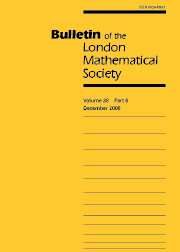Article contents
REVERSIBLE RINGS
Published online by Cambridge University Press: 01 November 1999
Abstract
Commutative rings form a very special subclass of rings, which shows quite different behaviour from the general case. For example, in a (non-trivial) commutative ring, the absence of zero-divisors is sufficient as well as necessary for the existence of a field of fractions, whereas for general rings, another infinite set of conditions is needed to characterize subrings of skew fields. This suggests the study of a class of rings which includes all commutative rings as well as all integral domains: reversible rings, where a ring is called reversible if ab = 0 implies ba = 0. It turns out that this condition helps to simplify other ring conditions, as we shall see in Section 2, although most of these results are at a somewhat superficial level. We therefore introduce a more technical notion, full reversibility, in Section 3, and show that this is the precise condition for the least matrix ideal to be proper and consist entirely of non-full matrices. Further, we show in Section 4 that a fully reversible ring is embeddable in a skew field if and only if it is an integral domain.
In what follows, all rings are associative, with a unit element 1 which is preserved by ring homomorphisms, inherited by subrings and acts unitally on modules.
I am grateful to V. de O. Ferreira for his comments, in particular the suggestion of using the notion of unit-stable rings.
- Type
- NOTES AND PAPERS
- Information
- Copyright
- © The London Mathematical Society 1999
- 139
- Cited by




